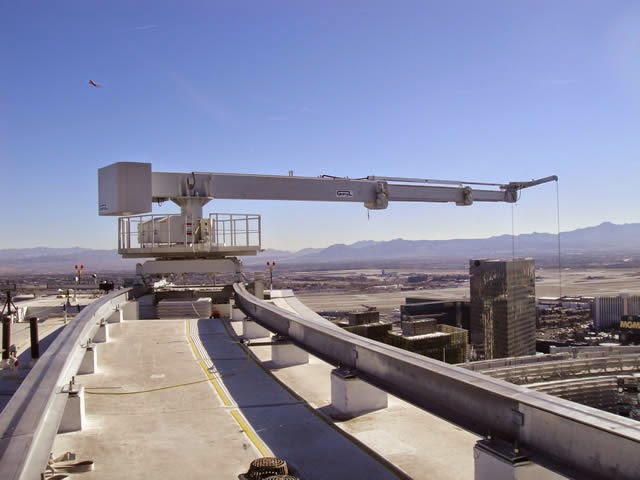In the realm of modern architecture, the maintenance and upkeep of high-rise buildings pose unique challenges. Due to fast urbanisation, an increase in commercial buildings, and high building heights, the demand and need for façade access is constantly rising. In order to ensure safety and easy access to the external surfaces of such buildings, facade access systems are emerging as an efficient and crucial solution. Facade access is a process of accessing and maintaining the external surfaces of buildings for various purposes, such as cleaning, maintenance or repairs.
A major concern is ensuring workers' safety while considering the complex architectural features of today's structures. Facade access solutions refer to the various methods, systems, and equipment used to provide safe and efficient access to the exterior surfaces of a building for maintenance, cleaning, and repair purposes. These are designed to resolve the problems relating to working at heights and accessibility in difficult, inaccessible areas on a building's facade.
5 Major Types of Facade Access Systems
Each facade access system is tailored to address specific requirements, such as building height, design complexity, and maintenance needs. The types of facade access systems are as follows:
- Building Maintenance Units (BMUs):
These movable platforms and cots move along the tracks or on davit systems, allowing workers access to different parts of the building's facade. High-rise buildings are often covered by BMUs, which offer flexibility to reach different altitudes and angles.
- Rope Access Systems:
It refers to the use of ropes, harnesses, and special tools for accessing and working on facades. The rope access operator is trained for the secure operation of horizontal surfaces to carry out various tasks such as cleaning, maintenance and inspection.
- Suspended Scaffolding:
This method implies the construction of scaffolding which may be anchored to the roof or another support structure. To allow workers to come into different areas of the wall, suspended scaffolding ensures a solid working platform.
- Ladder Systems:
Ladders may be used as a solution for facade access requirements in low-rise buildings or areas with limited accessibility needs. The ladder may be fixed or temporary and is usually used for short tasks, while other techniques are out of the question.
- Roof Rigging Systems:
In order to guarantee safety, these systems are equipped with anchor posts, stairways and security lines on the roof. Workers can perform maintenance or cleaning tasks on their own by securing themselves to the rigging system.
Design Implementation of Facade Access Systems
While designing facade access systems, they must be integrated with the building construction, taking into account the structural elements and adjusting their solutions for architecture's features:
Integration into Building Design:
The integration of facade access systems is evaluated with care during the early design phase of a building. The architects shall work together with structural engineers and facade consultants to arrive at the best placement of anchor posts, track systems as well as any necessary components. The overall aesthetic and functional characteristics of the facade access system are improved with the integration of these elements within the building's design.
Structural Considerations:
A complete understanding of the building's structural capacity is required. To ensure that the facade, roof, and associated supporting elements are able to cope with an increased amount of force from the access system, it is consequential for architects to look at their load capacity. The factors which form part of this assessment are wind speed, loading weight and movement of the entry components.
Customization for Architectural Features:
There are unique architectural characteristics in a number of modern buildings, such as curves, recesses and irregular shapes. In order to take account of these characteristics and ensure safe and effective access, facade access systems need to be adapted. This may involve the development of specialised track systems, adjustment platforms or flexibility support mechanisms for adapting to the special characteristics of a building.
Importance of Facade Access Solutions:
Facade access solutions make an important contribution to the long-term functionality, appearance, and value of a building through proper planning and implementation.
- Preservation of Aesthetics:
The conservation of the architectural beauty of a building is one of the main reasons for introducing facade access systems. It helps remove dirt, grime and pollutants accumulated over time by using such systems for regular cleaning and maintenance. The building's charm, which contributes to the overall attractiveness and adds worth, is preserved through good maintenance because of facade access.
- Preventing Deterioration and Damage:
The structure's facade is constantly subjected to environmental elements such as weather conditions, pollution and UV radiation. These factors may lead to deterioration and degradation of the exterior material, such as corrosion, fading or cracks, without adequate maintenance.
In order to prevent further deterioration and prolong the life of the building, facade access solutions allow timely inspections, repairs and protective measures.
- Safety of Maintenance Personnel:
Facade access to a building shall be done with utmost care to guarantee the safety of maintenance personnel. The facade access systems minimise the risks linked to conventional methods and alternative ways of accessing buildings by providing a controlled and safe working environment at height. The staff can perform their duties with a reduced hazard of injury or fall when using safety systems, such as harnesses, ropes and emergency equipment.
- Compliance with Regulations and Standards:
Facilities and buildings are subject to various regulations and safety standards regarding maintenance and access. To ensure compliance with local legislation, occupational safety standards and industry guidelines, facade access solutions are designed to meet these requirements. Legal matters and potential liabilities can be avoided by building owners and managers if they comply with the regulations.
Bottom Line
A vital part of today's construction practice is the facade access system. These systems enable regular maintenance, cleaning and repair work to be carried out by providing secure and efficient access to building facades. The impact of the facade access systems on buildings will continue to increase as demand for taller buildings increases, promising that these architectural icons will continue to function and look stunning in years to come.
If you are looking for reliable facade access solutions, our team of professionals and excellent facade access systems have got you covered. Get in contact with us at Facade Access and Davits!


No comments yet